The Sea Post Office on Steamships – A Crucial Link in Transatlantic Communication
📌 Discover the fascinating history of Sea Post Offices aboard steamships, ensuring efficient transatlantic mail delivery between Europe and America. Learn how these floating postal stations operated, their importance in ocean travel, and how they shaped global communication. A must-read for maritime historians, genealogists, and educators.
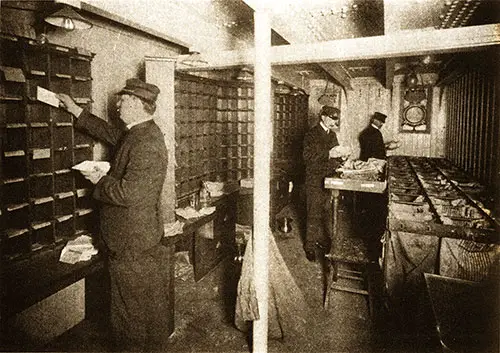
The Sea Post Office on the Oceanic circa 1910. | GGA Image ID # 1799721173
The Sea Post Office on Steamships – The Backbone of Transatlantic Communication 🚢📬📜
The Sea Post Office was a crucial yet often overlooked aspect of transatlantic travel that played a vital role in the global postal system. For steamship passengers, businesses, and even entire nations, these floating post offices ensured the timely processing, sorting, and distribution of mail between Europe and America.
This article sheds light on the remarkable efficiency of sea post offices, the personnel involved, the challenges of handling vast amounts of mail at sea, and their role in early 20th-century communication networks. The detailed descriptions and rare historical images make this an invaluable resource for teachers, students, genealogists, and maritime historians.
On many trans-Atlantic lines having mail contracts, a "marine post office" operates. There are sea post offices on nearly all express steamers belonging to lines with mail contracts.
The post office proper is usually located on the steamer's main deck, while a large storage room is below it, say, two decks lower. The post office is provided with the requisite sorting shelves, pigeon holes, packing and stamping tables, and bag stands, which secure the bags for the reception of the sorted letters.
The officials communicate with passengers through a window in the room's door (when necessary). The registered mail is sorted in a specially screened-off space.
The storage rooms are usually connected to the post office by electric elevators. If the mail is so bulky that the office rooms are insufficient for accommodation, part of the sealed mail sacks are stored in the ship's hold.
The post office clerks are accommodated in the first cabin, and the subalterns in the second cabin. On one of the German lines, for example, the staff consists of two German and two United States post office clerks and three German post office subaltern officials, furnished by the postal administration of the German Empire alone because this class of officials is not known in the United States postal service, where the post office clerks attend to the work done by the German subalterns.
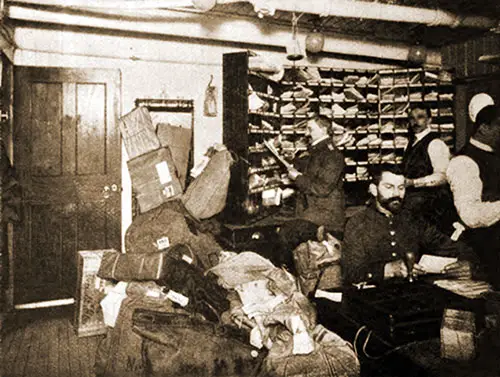
Sea Post Office Sorting the Printing Mater on a Liner of the North German Lloyd. History and Organisation of the Norddeutscher Lloyd, 1908. | GGA Image ID # 20e3ee1f5a
In the direction towards America, the German post office clerk, and on the trip to Germany, the United States post office clerk is the chief official of the sea post office on board and is responsible for the mail. The passengers are not admitted to the sea post office rooms.
It is the principal business of the post office clerks on the trips to New York to sort the United States mail, mainly letters and postal cards, in such a manner that they are ready either for immediate delivery in New York City or for transfer by the next inland mail; on the trips to Germany, the mail for the German terminal post offices is to be dealt with to have a large portion of the German mails ready for disembarkation at Plymouth and Cherbourg, whence they are forwarded to the places of destination by the faster overland routes.
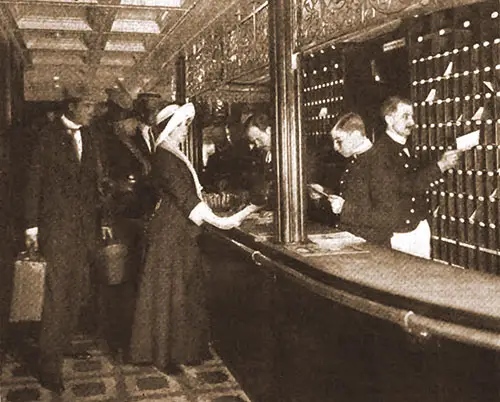
The Modern Ocean Liner's Post Office. One of the Conveniences of Ocean Cruises Today. Mail for Passengers Is Brought on Board the Ship and Distributed Just as in an Ordinary Post Office. Leslie's Illustrated Weekly Newspaper (26 March 1914) p. 296. | GGA Image ID # 179985154e
The post office clerks are, moreover, responsible for the systematic transfer and safe storage of the mail, for the emptying of the ship letterboxes, and the handling of the correspondence deposited therein; they have to attend to ordinary and registered correspondence handed in at the post office window by the passengers and crew, to sell postage stamps, postal cards, etc., to the passengers and crew, to distribute correspondence arrived for the latter, and to watch over the safe delivery of the closed mails at the ports of call and the terminal port of the voyage.
Furthermore, it is the business of the sea post office clerks to receive telegrams from the passengers and crew during the trip from the last port of call to the German terminal port, to prepay them, and forward them to the place of destination immediately after landing in the German port by a telegraph messenger provided by the post office of the said port.
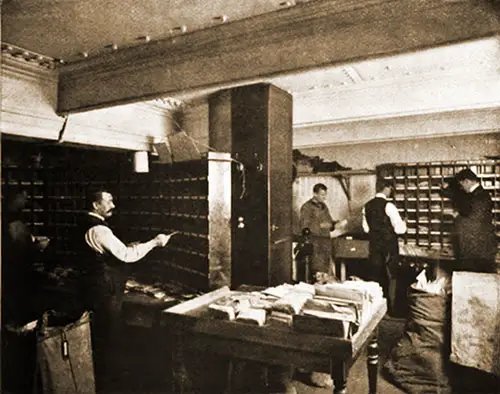
Letter Sorting Room on the SS Kaiser Wilhelm II. History and Organisation of the Norddeutscher Lloyd, 1908. | GGA Image ID # 20e3e359ca
The sea post offices keep a stock of postage stamps, etc., of both the German and United States postal administrations for sale; for the payment of the postage, German postage stamps must be used when the articles are posted in German ports or on the trip from Germany to New York. Postage stamps of the United States must be used when the correspondence is posted in ports of the United States or during the trip from New York to Bremerhaven.
During the steamer's stay at ports of call, only such letters can be received as they are prepaid by postage stamps of the country where the port of call is located.
Since January 1, 1900, a new tariff is in force by which letters are carried between the United States and Germany, and the United States and England, for two cents per half ounce.
The ship letterboxes must be emptied at least once a day and immediately before the arrival at each port touched on the line.
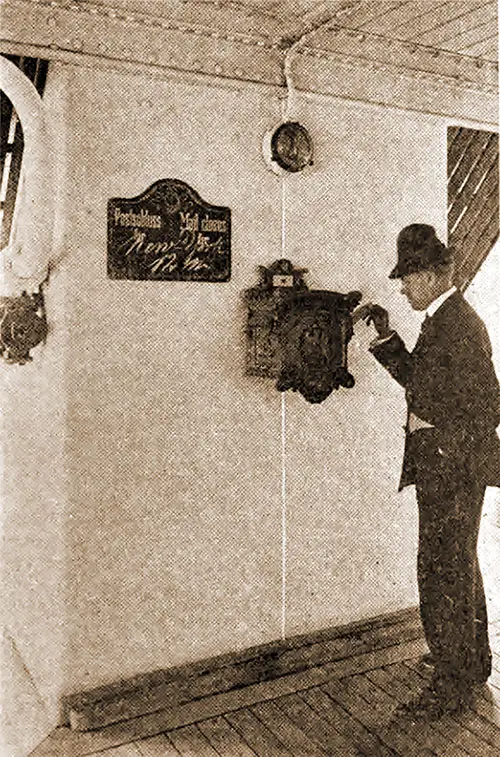
A Passenger Mails a Letter at Sea, Dropping His Mail Into a Collection Box Onboard the Ship. | GGA Image ID # 17998443f2
All correspondence taken from the boxes is stamped with the date stamp, which is changed daily. During the steamer's stay at ports of call, the ship letterboxes must be kept closed to avoid letters prepaid by other than the stamps admissible for the respective country being dropped into them.
Upon the arrival of the steamer at the Quarantine Station at Staten Island, the United States Mail steamer is found waiting to take the mail and convey it quickly to the harbor post office in New York when the mail carts carry it to the district post offices or the railway stations.
The time is undoubtedly near when all fast steamers plying between New York and foreign ports will be fitted with floating post offices in which European and United States post office clerks will affect the postal traffic between the three continents of Europe, America, and Asia for the benefit of trade and industry.
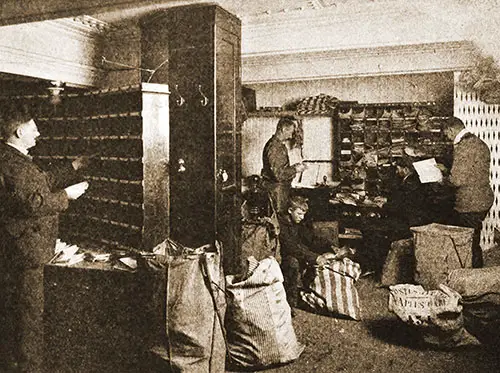
A Busy Sea Post Office With Many Mail Sacks To Sort Before Arriving at the Voyage's Final Destination. | GGA Image ID # 1799892b33
LETTERS FOR RETURN BY PILOT
Passengers desirous of sending letters to friends should have them ready and stamped at least half an hour before the pilot is dropped.
On vessels leaving New York, American stamps must be affixed; on vessels leaving England, English stamps must be used, and the same with other foreign countries.
During the voyage, letters may be posted in the special box provided for the purpose, and where there is a sea post office, they will be sorted en route.
Passengers wishing to send telegrams, cablegrams, or Marconi-grams should apply at the purser's office. That official or his clerk usually issues a receipt for the amount of the charges paid.
Passengers should keep these receipts, as complaints about the loss of telegraphic messages cannot be remedied if no receipts can support such claims.
NIGHT LETTER SERVICE
On March 5, 1910, the night letter service was inaugurated. The underlying thought in establishing this service was to give the public the benefit of the unemployed wires at night to quicken correspondence at low rates to replace letters by mail.
The rates charged are the standard day rates for ten-word messages. For the transmission of fifty words or less plus one-fifth the initial for each additional ten words or less.
To be entitled to this rate, the message must be written in plain English and destined for points where the telegraph companies have offices.
Code messages will be charged at standard day or night rates, as the case may be, and night letters will not be accepted for other line points.
Night letters will be accepted and collected on call at any hour or night for delivery at the destination on the morning of the next business day by mail or messenger. They will be transmitted at the company's convenience during the night.
The particular form, "Form 2289," should be used for writing the night letter. Night letters, at the option of the telegraph company, may be mailed to the destination of the addressee. The company shall be deemed to have discharged its obligations concerning delivery by sending such night letters to the destination, with postage prepaid.
Central will transmit to the next telegraph office so that a telephone subscriber may accept a telegram at any time during the twenty-four hours.
This may be modified in some manner when complete instructions are prepared, but this is about what the combined telegraph-telephone service will be.
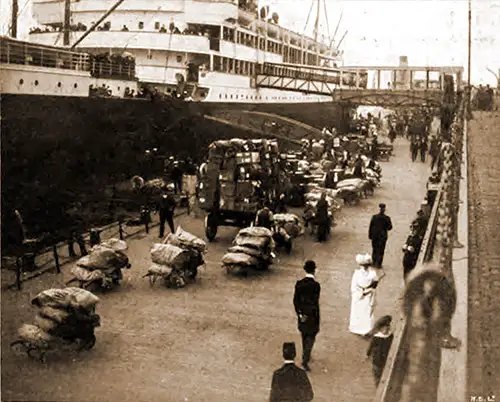
The Allan Line Turbine Steamship RMS Virginian Alongside the Liverpool Landing Stage, Waiting to Receive the Numerous Bags of Letters Which, In the Course of a Few Days, Will Reach All Parts of Canada. The Syren and Shipping, 25 September 1907. | GGA Image ID # 17b8335777
Sending Letters Abroad
Be sure to give all of your friends instructions to forward their mail care of a banker or tourist company, or the American Express Co. from whom you purchased tickets, etc.
Great care is taken with mail, and it is forwarded according to instructions. Select an office of these companies in some large city, have all the mail sent there, and give this office-specific information about your movements.
The American Express Co. gives the following advice relative to the forwarding of letters and telegrams, as well as the registered cable addresses. Duplicate lists will be found in their "Notes of Interest," mailed by the Company upon request.
Cablegrams sent through them should be arranged for in advance. Travelers are naturally expected to patronize companies or bankers who perform services for them by giving them a share of their business either in the transmittal of funds or the purchase of steamship and railway tickets.
Letters regarding mail or telegrams should be on sheets separate from communications on other subjects. Married ladies, to prevent delay in their letters and telegrams' forwarding, should state both their and their husbands' given or Christian names when requesting the offices to transmit such matters.
Inquiries regarding reforwarded mail and telegrams will be promptly attended to at the Company's European offices. However, patrons should remember that the Company is not accountable for such matters after mailing.
The European post office departments do not assume responsibility for promptly transmitting mail matters. They will not answer inquiries concerning the delivery of newspapers.
Patrons requesting the Company's offices in Europe to open and reforward by wire their cablegrams and telegrams will be expected to deposit against charges. Unopened cablegrams and telegrams will be reforwarded by mail without such a deposit.
In going out of the harbor, letters may be given to the pilot for mailing when he leaves the vessel after taking her out.
Letters and telegrams for delivery to passengers on board ocean steamships should be addressed as follows:
"Mr _________________________
Passenger S. S. ____________________
New York City, N. Y.,"
"Boston," "Liverpool." or whatever the port may be, and the envelope should also show the name and address of the sender.
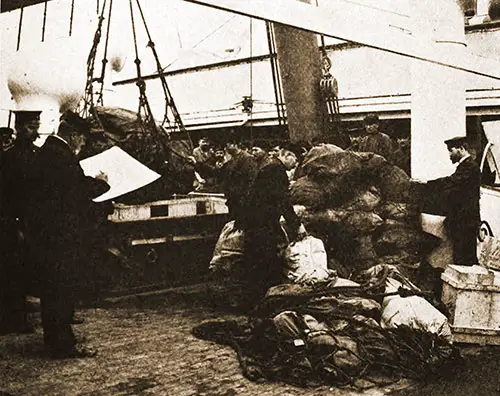
Sacks of Mail Being Brought Onboard a Royal Mail Ship circa 1910. | GGA Image ID # 179999098c
A RECORD BREAKER
The Kaiser Wilhelm II of the North German Lloyd brings a Heavy European Mail.
On a recent trip from Bremen to New York, the express steamer Kaiser Wilhelm II of the North German Lloyd carried an extraordinarily heavy mail.
To meet this flood of mail, the postal officials on board were compelled to do some strong "swimming," to quote the phrase they used.
In Bremerhaven alone, they had received 500 bags of mail. On their arrival in Southampton, they found at least 12 mail cars, an entire train filled with mail bags from England and the Continent on the pier, ready to unload. Shortly after, two more cars arrived on late trains.
Taking on board this enormous mass of mail, consisting of 1,920 bags, the most significant amount of mail ever taken on board a German steamer in an English Harbor, took 4 1/2 hours.
Four German officials and subordinates were in this service, two American officials, three English officials, and about fifty laborers and sailors.
The sorting of this mail on the pier, the loading of the same employing a hydraulic crane that took thirty to fifty bags wrapped in a net, lifted them in the air and then deposited them in the vessel's hold. The long rows of carriers offered the most remarkable and impressive picture.
Several London correspondents were present, a representative of the "Daily Chronicle," who had come over specially to see them taking on board of this immense mail. At Cherbourg, 420 more bags of mail were added to the large mass in the afternoon.
The 2,840 bags on board realized a weight of 85,000 kilograms, made up of 1,000 bags of mail holding about 320,000 letters. This immense accumulation included all of Europe, from the Norwegian seaport towns, Bergen, Newcastle, and Kristiansand-Frederikshavn to the Ottoman mail-in Constantinople. There were also bags of mail from Buenos Aires, Cairo, and Alexandria.
On the trip to New York, the mail was sorted so that the mailbags could be transmitted to North and Central America, Venezuela, Columbia, Ecuador, Peru, northern Bolivia, West Indies, Japan, and Samoa.
There was destined for Chicago, Ill., 133 bags; San Francisco, Cal., 41; New Orleans, 18; Havana, 67; Mexico, D.F., 119; Guatemala (Land) 14; Lima (Peru), 13; and Tokyo, 15.
On the New York return voyage, the steamer carried 2,005 mail bags for Plymouth, Cherbourg, and Bremerhaven. This mail was also from many countries.
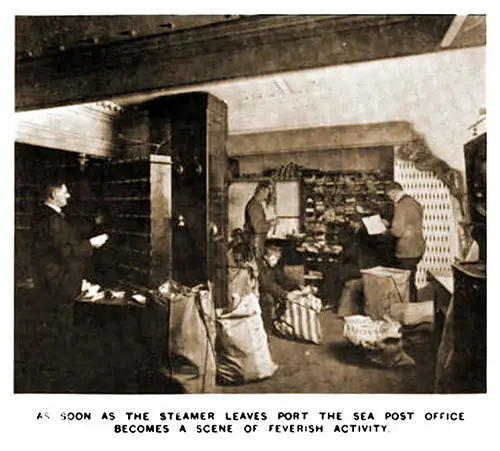
As Soon as the Steamer Leaves Port, the Sea Post Office Becomes a Scene of Feverish Activity on a Norddeutscher Lloyd Express Steamship, ca. 1909. The Syren and Shipping, 24 November 1909. | GGA Image ID # 210115e93f
“A Record Breaker. The Kaiser Wilhelm II of the North German Lloyd Brings a Heavy European Mail,” in North German Lloyd Bulletin, New York and Bremen: Norddeutscher Lloyd, Vol. XXI, No. 4, December 1910, pp. 1-2.
Why This Topic is Important
For Teachers & Students 📚
✅ An excellent case study on global communication before digital technology
✅ A primary source for understanding how the maritime industry facilitated international trade & correspondence
✅ Helps students explore the intersection of ocean travel, postal services, and technological advancements
For Genealogists 🏡
✅ Understanding the mailing system onboard transatlantic steamers helps explain lost or delayed family correspondence
✅ Provides historical context for passenger lists, ship manifests, and postal records
✅ Helps identify potential sources of communication between immigrants and their families back home
For Historians & Maritime Enthusiasts ⚓
✅ Highlights the role of steamship companies in revolutionizing international communication
✅ Provides insight into shipboard logistics, including how mail was stored, sorted, and distributed
✅ Offers a glimpse into the working conditions of sea post office clerks
Most Fascinating Aspects of This Article
1. The Efficiency of Mail Processing at Sea 📬✉️
The article details how thousands of letters and packages were processed onboard while ships crossed the Atlantic.
🔹 Mail was sorted in real-time by dedicated postal clerks, ensuring its immediate delivery upon arrival in port.
🔹 Electric elevators connected the mail storage areas to the sorting rooms, demonstrating early advancements in shipboard logistics.
🔹 Each mailbag was carefully cataloged, with some sorted en route for distribution at intermediate stops like Plymouth and Cherbourg before reaching New York.
💡 Why It’s Interesting: Before airmail, steamships were the fastest way to deliver international mail. This system ensured that letters from Europe reached North America within days instead of weeks.
2. The Exclusive Role of Postal Clerks 🏛️👨✉️
The postal clerks onboard transatlantic liners were an elite group of professionals, often drawn from both the United States and European postal services.
🔹 German and American postal clerks worked side by side, ensuring mail was sorted according to its final destination.
🔹 Only authorized personnel were allowed inside the sea post office—passengers were strictly prohibited.
🔹 Some steamship companies, such as North German Lloyd, employed subaltern officials (a job classification not used in the U.S.), further highlighting cultural differences in postal administration.
💡 Why It’s Interesting: This collaboration between nations in handling mail efficiently demonstrates early examples of global cooperation in communication infrastructure.
3. Passenger Services – Mailing Letters at Sea 📮📝
Passengers could send and receive mail onboard via letterboxes placed throughout the ship.
🔹 The ship’s purser handled telegrams, cablegrams, and Marconi wireless messages, ensuring instantaneous communication with the outside world.
🔹 Different postage was required depending on the ship’s location (U.S. stamps were needed on voyages leaving New York, while German or British stamps were required on outbound journeys from Europe).
🔹 Letters could be sent via the ship’s pilot as the vessel left port, ensuring quick land-based delivery.
💡 Why It’s Interesting: This direct mail service at sea was a luxury of its time, allowing passengers to stay connected long before the advent of emails and mobile phones.
4. The Sheer Volume of Mail Carried by Steamships 📦📤
One of the most astonishing details in this article is the record-breaking amount of mail carried on some voyages.
🔹 The SS Kaiser Wilhelm II once transported 2,840 mailbags, weighing 85,000 kilograms, carrying over 320,000 letters from across Europe, South America, and the Middle East.
🔹 The onboard postal clerks worked tirelessly throughout the voyage, ensuring that letters for Chicago, San Francisco, Mexico City, and Tokyo were pre-sorted for immediate dispatch upon arrival.
🔹 Mail distribution wasn’t just between the U.S. and Europe—steamships also facilitated connections with Asia, South America, and the Caribbean.
💡 Why It’s Interesting: This highlights the enormous role of ocean liners in global communication, as these ships served multiple continents in a single voyage.
5. Future Predictions: The Expansion of Sea Post Offices 📡🌍
The article concludes with a bold prediction—that all major ocean liners would eventually be equipped with Sea Post Offices.
🔹 The vision was to create a network where mail would be sorted and dispatched in transit, reducing delays in international communication.
🔹 While aeroplanes eventually replaced ships as the primary means of transatlantic mail transport, these early innovations laid the foundation for modern global postal logistics.
💡 Why It’s Interesting: The maritime postal system foreshadowed modern global shipping logistics, where companies like FedEx and UPS now ensure rapid international deliveries using similar principles.
Key Takeaways for Research & Essay Writing
📌 For Students & Teachers:
🔹 A perfect topic for research papers on early global communication networks
🔹 Highlights the importance of steamships in trade, migration, and connectivity
🔹 A great way to examine how innovations in one sector (maritime travel) influenced another (postal services)
📌 For Genealogists & Family Historians:
🔹 Provides context for how immigrant families kept in touch across continents
🔹 Explains why some letters might have been delayed or lost in transit
🔹 Helps researchers understand postal records related to transatlantic voyages
📌 For Historians & Maritime Researchers:
🔹 Sheds light on how sea post offices shaped the efficiency of the early global economy
🔹 Demonstrates the technological advancements in logistics and communication onboard ocean liners
🔹 Serves as an excellent case study on international cooperation in postal services
Final Thoughts: Sea Post Offices as the Lifeline of Ocean Travel
The Sea Post Office system onboard transatlantic steamships was a marvel of efficiency and logistics that kept the world connected before the age of air travel and the internet. This article is an exceptional resource for anyone interested in maritime history, immigration, or global communication networks.
💡 How did the transition from sea mail to airmail impact international relations? How do modern cargo and mail transport systems compare to those used on ocean liners? 🤔
🔍 Explore the world of Sea Post Offices and uncover the hidden history of global communication at sea! 🚢📮
